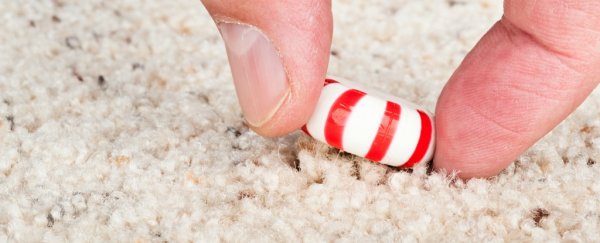Researchers have once again debunked the 5-second rule, where food is apparently 'safe' to eat if dropped on the floor and picked up within 5 seconds.
By testing various foods on different surfaces to see how fast bacteria transfers to it, they found that bacteria can jump on our dropped snacks in under 1 second, which of course is bad news for clumsy eaters everywhere.
"The popular notion of the '5-second rule' is that food dropped on the floor, but picked up quickly, is safe to eat, because bacteria need time to transfer," said team member Donald Schaffner from Rutgers University.
"We decided to look into this because the practice is so widespread. The topic might appear 'light', but we wanted our results backed by solid science."
The team chose four different types of surface - stainless steel, ceramic tile, wood, and carpet - and selected a number of different foods to drop on them, including watermelon, dry bread, buttered bread, and gummy candies.
They grew Enterobacter aerogenes - a safe, non-pathogenic relative of Salmonella - in the lab, and covered their test surfaces in it.
Each piece of food was then dropped on each bacteria-covered surface, and left there for various amounts of time: 1 second, 5 seconds, 30 seconds, and 300 seconds.
A total of 128 different scenarios trials were completed and replicated 20 times, adding up to 2,560 individual measurements that were used to analyse the amount of contamination on each food item.
The team found that the biggest factor when it came to bacteria transfer was the amount of moisture present in the food, followed by the type of surface it's being dropped onto. And while bacteria didn't hesitate to transfer over, the longer food was left, the more bacteria found its way over.
"Transfer of bacteria from surfaces to food appears to be affected most by moisture," Schaffner said. "Bacteria don't have legs, they move with the moisture, and the wetter the food, the higher the risk of transfer. Also, longer food contact times usually result in the transfer of more bacteria from each surface to food."
The team says that even though they found that longer contact times did lead to higher levels of contamination, picking up food in less than 5 seconds is still enough time for bacteria to transfer - especially if the food is wet or sticky like watermelon or candy, which had the highest levels of contamination across the tests.
"The 5-second rule is a significant oversimplification of what actually happens when bacteria transfer from a surface to food," Schaffner says. "Bacteria can contaminate instantaneously."
There were some surprising finds, too. You might think that carpet - with its tendency to catch crumbs and get dirty rather quickly - would be the worst thing to eat off of, but the researchers found that it's actually the best, because its structure minimises the amount of contact it has with the food.
The Rutgers team isn't the first to debunk the 5-second rule - there have been other peer-reviewed studies about it and TV shows have tackled it, too. But they hope that their concrete analysis of different types of foods and surfaces will help people to understand how the popular piece of advice is not something you want to base your hygiene practices around.
The team's work was published in Applied and Environmental Microbiology.
